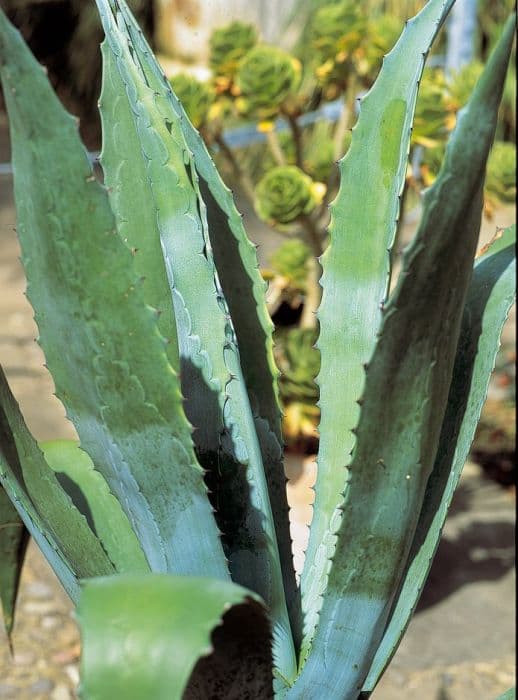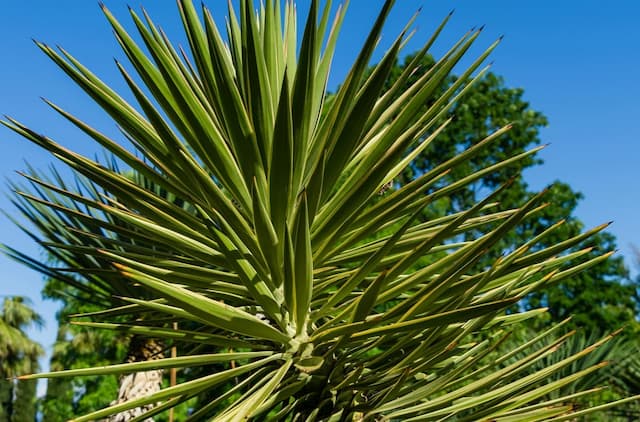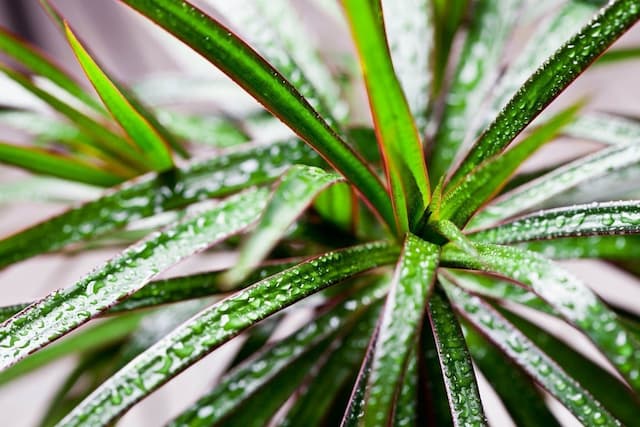Asparagus densiflorus 'Myersii'

ABOUT
The plant commonly known as Foxtail Fern is a perennial evergreen that is well-known for its attractive, bushy clumps of plume-like foliage. This ornamental plant has a unique appearance with its upright, emerald green stems that are densely packed with soft, needle-like leaves. These leaves give the stems a fluffy, fern-like texture that resembles the tail of a fox, hence its common name. The Foxtail Fern produces stems that arch gracefully and have an almost feathery look, which makes them popular in both garden landscapes and as interior houseplants. The plant has a lush, vibrant green color that adds a bright and lively touch to any setting. Occasionally, it may produce small white flowers, followed by red berries that can add an extra layer of interest to its appearance. Overall, the Foxtail Fern is favored for its showy foliage and its ability to bring a textural contrast to floral arrangements, gardens, and container plantings. Its distinctive, fluffy fronds make it a delightful choice for those seeking a plant with a unique and lush visual appeal.
About this plant
 Names
NamesFamily
Asparagaceae
Synonyms
Foxtail Fern, Myers Asparagus, Myers Foxtail Asparagus, Asparagus Fern
Common names
Asparagus densiflorus 'Myers', Protasparagus densiflorus 'Myersii'.
 Toxicity
ToxicityTo humans
Foxtail fern is not considered highly toxic to humans. However, it can cause mild stomach upset if ingested. The berries of the plant are more likely to cause digestive discomfort including nausea, vomiting, and diarrhea. Although severe reactions are uncommon, if a significant amount is ingested, especially by children, it is advisable to seek medical attention.
To pets
Foxtail fern is mildly toxic to pets such as cats and dogs. If ingested, pets may experience gastrointestinal symptoms including vomiting, diarrhea, and abdominal pain. The berries of the plant are known to be more problematic and can cause more severe symptoms. In case of ingestion, it is recommended to contact a veterinarian. Continuous monitoring of the pet for any developing symptoms is important, and providing care as advised by the veterinarian should minimize the risk of severe consequences.
 Characteristics
CharacteristicsLife cycle
Perennials
Foliage type
Evergreen
Color of leaves
Green
Flower color
White
Height
2-3 feet (0.6-0.9 meters)
Spread
2-4 feet (0.6-1.2 meters)
Plant type
Shrub
Hardiness zones
9
Native area
South Africa
Benefits
 General Benefits
General Benefits- Ornamental appeal: Adds an attractive, feathery texture to garden beds or pots with its dense, bushy foliage that resembles a fern.
- Low maintenance: Requires minimal care once established, tolerates neglect, and is relatively drought-tolerant.
- Long-lived perennial: Survives for many years, offering long-term presence in the garden.
- Versatility in landscaping: Suitable for use in a variety of garden styles, including formal, tropical, and container gardening.
- Non-invasive: Unlike its vegetable counterpart, does not tend to spread uncontrollably, which prevents it from overtaking other plants.
- Wildlife attraction: Can attract butterflies, providing a lively and dynamic element to the garden ecosystem.
 Medical Properties
Medical PropertiesThis plant is not used for medical purposes.
 Air-purifying Qualities
Air-purifying QualitiesThis plant is not specifically known for air purifying qualities.
 Other Uses
Other Uses- Foxtail ferns can be used as natural dyes, especially when seeking green or yellow hues for fabrics or handicrafts.
- In floral arrangements, the fronds of foxtail ferns add texture and a lush, green backdrop for colorful flowers.
- These plants can be used for terrariums or fairy gardens due to their compact growth and interesting foliage.
- As a thematic element in reptile or amphibian enclosures, foxtail ferns can mimic the natural habitat for certain species.
- Foxtail ferns can be used as living hair accessories or boutonnieres when secured properly, providing a unique and organic touch for special occasions.
- In photography, the plants can serve as a natural prop or background to enhance the composition of the shot with their feathery leaves.
- When planted in hanging baskets, foxtail ferns can create elegant, cascading greenery for outdoor spaces.
- Their sturdy fronds can be used in crafts, such as making wreaths or incorporated into handmade paper for texture.
- Using non-toxic, preserved fronds of foxtail ferns can add an evergreen element to holiday decorations such as Christmas trees or garlands.
- The dense foliage of foxtail ferns can serve as a natural privacy screen or green wall when grown densely in outdoor areas.
Interesting Facts
 Feng Shui
Feng ShuiThe Foxtail Fern is not used in Feng Shui practice.
 Zodiac Sign Compitability
Zodiac Sign CompitabilityThe Foxtail Fern is not used in astrology practice.
 Plant Symbolism
Plant Symbolism- Foxtail Fern - As the common name for Asparagus densiflorus 'Myersii', the foxtail fern can symbolize perseverance and resilience, reflecting its hardy nature and ability to thrive in various conditions.
- Eternal Youth - The lush, evergreen foliage of the foxtail fern may represent youthfulness and the idea of staying young at heart, as the plant maintains its vibrant green color throughout the year.
- Fertility - Historically, asparagus plants have been associated with fertility due to their vigorous growth and reproductive structures, and the foxtail fern is no exception with its bushy, plume-like appearance.
- New Beginnings - The foxtail fern's growth pattern and renewal process can symbolize new beginnings or fresh starts, making it an ideal plant to gift when someone is embarking on a new chapter in their life.
 Water
WaterThe Foxtail Fern, which is the common name for Asparagus densiflorus 'Myersii', prefers consistent moisture without being waterlogged. Aim to water the plant thoroughly when the top inch of soil feels dry to the touch, which typically occurs once a week. However, during the growing season, you may need to water the plant as often as every 3 to 4 days, especially if it is in a hot environment, but always check the soil moisture level before watering. Provide about half a gallon of water per watering, ensuring it's distributed evenly around the plant. In winter, reduce watering to every other week or less, depending on the humidity and temperature of the environment.
 Light
LightFoxtail Fern thrives in bright, indirect light and can benefit from some direct morning sunlight. However, it should be shielded from the harsh afternoon sun to avoid leaf burn. An east-facing window is ideal for the Foxtail Fern, offering it the gentle morning light and protecting it from intense afternoon rays.
 Temperature
TemperatureThe Foxtail Fern prefers temperatures between 65-75 degrees Fahrenheit, which is the ideal range for its growth. It can tolerate a minimum temperature of 50 degrees Fahrenheit, ensuring that it should not be exposed to frost or temperatures below this threshold. The maximum temperature for the plant can stretch up to 90 degrees Fahrenheit without causing significant stress, but it's best to keep it in its ideal range when possible.
 Pruning
PruningPrune the Foxtail Fern to remove dead or yellowing fronds and to maintain its shape. This is best done in the spring before new growth begins. Pruning can be done every couple of years as needed, to keep the plant looking its best and to encourage fresh, healthy growth.
 Cleaning
CleaningAs needed
 Soil
SoilThe Foxtail Fern thrives in a well-draining soil mix consisting of two parts peat or coco coir, one part perlite or pumice, and one part loamy soil, ideal to support its root system. The best soil pH for the Foxtail Fern ranges from slightly acidic to neutral, around 6.5 to 7.5.
 Repotting
RepottingThe Foxtail Fern should be repotted every two to three years. This helps to replenish nutrients in the soil and provide room for the expanding root system. Choose a pot that's only slightly larger than the current one to prevent overwatering issues.
 Humidity & Misting
Humidity & MistingFoxtail Fern prefers a humidity level of around 40-50%. It can tolerate some degree of dry indoor air but will appreciate regular misting or a pebble tray with water to increase humidity around the plant.
 Suitable locations
Suitable locationsIndoor
Place in bright, indirect light, away from drafts.
Outdoor
Grow in partial shade, protect from strong sunlight.
Hardiness zone
9-11 USDA
 Life cycle
Life cycleThe life of Asparagus densiflorus 'Myersii', commonly known as Foxtail Fern, begins with seed germination, where seeds will sprout when sown in a well-draining soil mix under appropriate warmth and light conditions. Following germination, seedlings emerge, developing into young plants with characteristic needle-like foliage. Vegetative growth is evident as the plant matures, with the formation of dense, upright, plume-like stems that give it the appearance of a foxtail. This stage can be prolonged for several years with proper care, including moderate watering, occasional fertilizing, and adequate sunlight. The Foxtail Fern may eventually produce small white flowers, followed by red or orange berries, indicating its reproductive phase, which typically occurs in mature plants. After many years, the plant may decline as it reaches its natural lifespan's end, at which point it may be propagated through division to continue its legacy.
 Propogation
PropogationPropogation time
Spring to Summer
The popular method of propagation for Asparagus densiflorus 'Myersii', commonly known as foxtail fern, is through division. This is ideally done in the spring when the plant begins to grow more vigorously. Division involves carefully removing the plant from its container or garden space and gently separating the clumps of tubers and roots, making sure that each new section has a portion of roots attached. These divisions are then planted in well-draining soil and watered thoroughly to help establish the new plants. It is not recommended to propagate the foxtail fern through seed, as it can be slow and less reliable compared to division.









